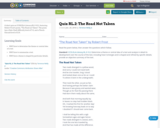
Contains blank organizer and student samples.
- Subject:
- Education
- Material Type:
- Lesson Plan
- Author:
- Stephanie Genco
- Date Added:
- 08/24/2018

Contains blank organizer and student samples.

This workshop is designed to help you write clearly, accurately and effectively in both an academic and a professional environment. In class, we analyze various forms of writing and address problems common to advanced speakers of English. We will often read one another’s work.

The Amoeba Sisters strive to facilitate curiosity and engagement by making biology both humorous and meaningful. The videos use real world examples and silly cartoons to demystify difficult biology concepts, such as cell anatomy, homeostasis, enzymes, and biomolecules. A new video is released weekly. The creators are sisters who both work in education. One is a high school biology teacher who found these videos made biology more approachable and easier to comprehend.

Summary is arguably the most important research-essay-writing skill. There are many methods for summarizing a text. This chapter of For the Love of Research: A Step-by-step Guide to Writing Research Papers provides one. If you are interested in checking out this workbook in its entirety. Please contact Debbie (me) at gilbertd@mjc.edu.

Summary of little girls are wiser than men

A short quiz on CCSS.ELA-Literacy.RL.9-10.2, featuring Robert Frost's poem, "The Road not Taken". The poem has a Dale-Chall difficulty level of 7-8, and a Flesch-Kincaid level of 12.8.

After reading your 'free choice' selection - please answer the following questions on a separate piece of paper. 1) Tell me three things that happened in your reading today? 2) Why did you pick those things? How do they relate to the story as a whole?3) What do you will predict will happen next? Why do you think that? (use evidence to support your answer)

A rubric in student language written for elementary students to self-assess the retelling of a story.

Learning Objectives:Student Learning ObjectivesAs a result of meeting the requirements in this course, you will be able to:1. Employ a variety of approaches to analyze and interpret texts. (PLG 1) (Gen Ed Goal 1 a)2. Respond to texts, in discussion and writing assignments, demonstrating an understanding of rhetorical strategies employed in the texts. (PLG 2) (Gen Ed Goal 1a, b; 6 a, b)3. Incorporate the fundamentals of academic essay writing such as gathering ideas, developing and clearly stating theses, organizing, drafting, revising, and editing. (PLG 3) (Gen Ed Goal 1 c, d) 4. Compose essays in several rhetorical modes, such as description, comparison/contrast, and argument. (PLG 3) (Gen Ed Goal 1c, d)5. Move from personal responses to formal academic essays, including appropriate, properly formatted evidence from outside sources. (PLG 4, 5) (Gen Ed Goal 1 c) 6. Accurately incorporate the ideas of others using summary, paraphrase, and direct quotation. (PLG 4, 5) (Gen Ed Goal 1 c; 6 b)7. Incorporate the academic requirements, tools, and techniques of research through the resources of contemporary information science. (PLG 6) (Gen Ed Goal 4 a, b, c, d)8. Employ current MLA style for text presentation, in-text citations, and Works Cited pages for essays and research papers. (PLG 5, 6) (Gen Ed Goal 4 a, b, c, d)9. Write an argumentative research paper accurately incorporating material from outside sources. (PLG 4, 5, 6) (Gen Ed Goal 1 a, b, c, d; 4 a, b, c, d; 6 a, b)Course RequirementsYou will be required to do the following:Write at least four multi-paragraph assignments of at least 500 words.(Meets student learning objectives 1-5)Write at least one in-class essay. (Meets student learning objectives 2-5)Complete other writing exercises such as summaries, journals, reading responses, reading comprehension questions, quizzes on reading assignments, letters, resumes, etc. (Meets student learning objectives 1-6)Read, interpret, and analyze a variety of texts. (Meets student learning objectives 1, 2)Conduct independent research and write a 5-7-page research paper, using MLA style. (Meets student learning objectives 6-9)Submit papers that adhere to MLA manuscript requirements and which demonstrate effective proofreading and editing. (Meets student learning objectives 1-9)Participate in class discussions and other in-class (individual or group) activities necessary to produce quality expository prose. (Meets student learning objectives 2-7)

The purpose of this lesson is to help students develop their paraphrasing and summarizing skills. Focusing on the I do, We do, You do method, the lesson is collaborative between teachers and students. Objectives:paraphrase information in a nonfiction textconnect like ideas and combine sentencescreate a summary of a piece of nonfiction edit writing for mechanics, usage, grammar, and spelling errorspublish a summary Approx. Time: one week

Have you ever had such a hard time understanding what the book, "The Tale Of Two Cities?" I know I have, so I ended up making an animation that helps you understand what book 2, chapter 14 is talking about. In this chapter, you will find that there are a couple of characters, Cruncher, Cruncher Jr., Town Folks, Roger Cly, and much more. Cruncher Jr learned that his father sold dead bodies to earn income.


In this lab, students will discuss what movies and dramas they have watched. They will share their favorite movie or drama and give a simple summary of it. Students will learn to describe plot, characters, and action of a story. Additionally, they will describe preferences and explain the reason behind their preferences.